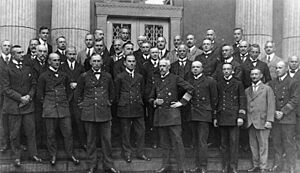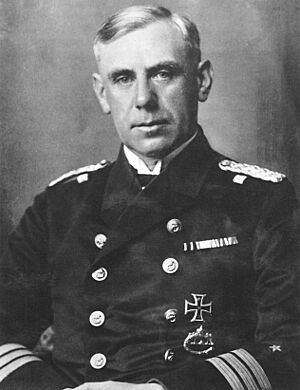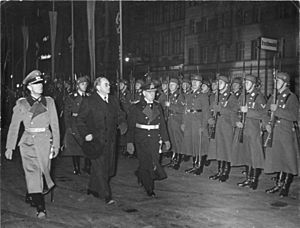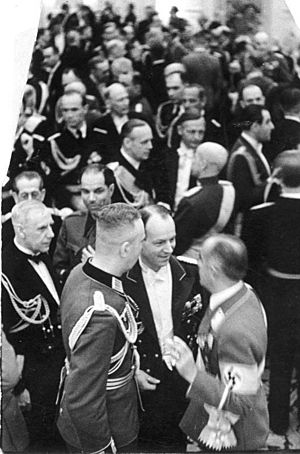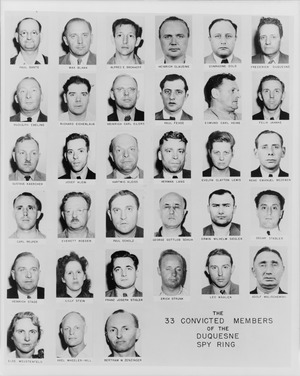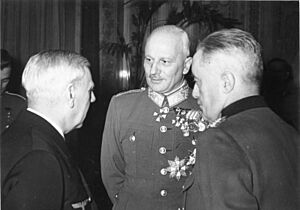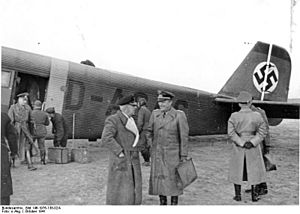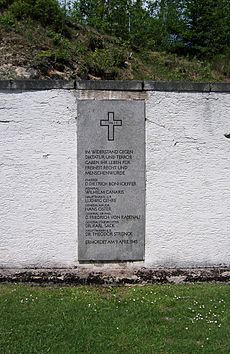Wilhelm Canaris facts for kids
Quick facts for kids
Wilhelm Canaris
|
|
|---|---|
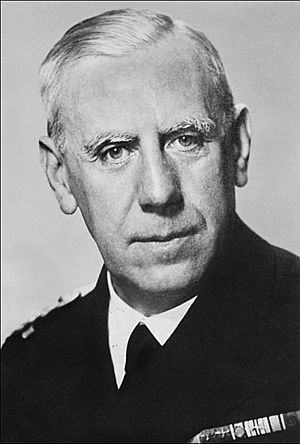
Canaris in 1940
|
|
| 5th Chief of the Abwehr | |
| In office 1 January 1935 – 12 February 1944 |
|
| Deputy | Hans Oster |
| Preceded by | Conrad Patzig |
| Succeeded by | Georg Hansen |
| Personal details | |
| Born |
Wilhelm Franz Canaris
1 January 1887 Aplerbeck, Landkreis Dortmund, Province of Westphalia, Kingdom of Prussia, German Empire |
| Died | 9 April 1945 (aged 58) Flossenbürg concentration camp, Flossenbürg, Nazi Germany 49°44′06″N 12°21′21″E / 49.734958°N 12.35577°E |
| Cause of death | Execution by hanging |
| Military service | |
| Allegiance | |
| Branch/service |
|
| Years of service | 1905–1944 |
| Rank | Admiral |
| Commands |
|
| Battles/wars | World War I World War II |
| Awards | Iron Cross (First Class) U-boat War Badge |
Wilhelm Franz Canaris (born January 1, 1887 – died April 9, 1945) was a German admiral. He led the Abwehr, which was Germany's military intelligence service, from 1935 to 1944. Canaris first supported Adolf Hitler and the Nazi government. However, after Germany invaded Poland in 1939, Canaris began to oppose Hitler. He secretly worked against the Nazi regime during the war.
As the head of Nazi Germany's spy agency, Canaris was in a key position to resist. As the war started to go badly for Germany, Canaris and other military officers secretly worked against the Nazi leaders. By 1945, his actions against the Nazis were discovered. Canaris was executed in Flossenbürg concentration camp for high treason as Allied forces moved into Southern Germany.
Contents
Wilhelm Canaris's Early Life
Canaris was born on January 1, 1887, in Aplerbeck, which is now part of Dortmund. His father, Carl Canaris, was a rich businessman. Wilhelm always wanted to be an officer in the Imperial Navy. After his father died in 1904, Canaris joined the navy in March 1905.
He went to the naval academy in Kiel. He learned how to be a sailor on a training ship called SMS Stein. In 1906, he became a midshipman. He continued his studies and in 1908, he served on SMS Bremen. This ship sailed near Central and South America. In August 1910, Canaris became a lieutenant.
Canaris in World War I
When World War I started in 1914, Canaris was a naval intelligence officer. He served on a light cruiser called SMS Dresden. This ship was the only one from Admiral Maximilian von Spee's squadron that avoided the British Royal Navy for a long time. This happened during the Battle of the Falkland Islands in December 1914.
After another battle, the Dresden was damaged. Its crew sank the ship to prevent it from being captured. Most of the crew were held in Chile. But in August 1915, Canaris escaped. He used his ability to speak Spanish fluently. With help from German merchants, he returned to Germany in October 1915. On his way, he even stopped in Plymouth, Great Britain.
Because of his clever escape, German naval intelligence noticed him. He was given intelligence work. He was sent to Spain, to Madrid. His job there was to secretly watch enemy ship movements. He also helped supply German U-boats in the Mediterranean Sea. In 1917, he became a U-boat commander.
He finished the war as a U-boat commander. He sank several ships and even caught the attention of the Kaiser. For his actions in Spain, he received the Iron Cross First Class. Canaris spoke six languages, including English. He respected Britain's Royal Navy, even though the two countries were rivals.
Between the World Wars
After World War I, Germany had a revolution. Canaris helped create groups called Freikorps. These groups tried to stop communist movements. He was part of a military court that judged people involved in the murders of revolutionaries Karl Liebknecht and Rosa Luxemburg. Canaris also helped one of the convicted people escape from prison. He was briefly jailed for this but never charged.
In 1919, he married Erika Waag. They had two children. Canaris worked to get weapons for the new German navy. He sold extra weapons through Denmark to raise money. He also worked with a right-wing group called Organisation Consul. This group received money and weapons from these sales.
In 1924, Canaris went to Osaka, Japan. He was there to oversee a secret U-boat building program. This was against the rules of the Treaty of Versailles. He also made deals with Spanish merchants and German businesses. This allowed Germans to continue secret naval activities.
Canaris faced some trouble in Germany. He lost his position in Spain and was sent to Wilhelmshaven. In 1928, he was removed from his intelligence job. He then served on the battleship Schlesien. He became the ship's captain in December 1932.
Just two months later, Adolf Hitler became Germany's new leader. Canaris was excited by this. He often gave talks to his crew about the good things about Nazism. He believed the Nazi Party would make Germany strong again. He liked that they wanted to ignore the Treaty of Versailles. Canaris also liked that the Nazis were against communism.
In September 1934, Canaris became the commander of a fortress. This seemed like the end of his career. But then, the head of the Abwehr (German military intelligence) had to resign. He recommended Canaris as his replacement. Canaris was chosen because of his excellent service and experience in intelligence.
On January 1, 1935, Canaris became the head of the Abwehr. He met with Reinhard Heydrich, who led the SS intelligence service. They agreed on how to divide intelligence work. Canaris was a strong supporter of Hitler at this time.
In May 1935, Canaris became a rear admiral. He was responsible for protecting Germany's growing military from enemy spies. This meant the Abwehr grew a lot. Between 1935 and 1937, the Abwehr staff grew from 150 to nearly 1,000 people. In December 1936, Canaris and Heydrich signed an agreement. It explained their spy responsibilities.
Canaris agreed with many of Hitler's ideas. He liked Hitler's nationalism and his desire to rebuild a greater Germany. Canaris suggested using the Star of David to identify Jewish people. This led to their separation from other German citizens.
During the Spanish Civil War (1936–1939), Germany secretly helped Francisco Franco's side. Canaris used his contacts to help supply weapons to Franco.
Before Hitler took over Austria (called the Anschluss), Canaris used the Abwehr to create a trick. They made it seem like Germany was preparing for a big attack. This was to scare the Austrians. However, Austrian Chancellor Kurt Schuschnigg resigned anyway. German troops marched into Austria, and it became part of Germany in March 1938.
Canaris became worried about Hitler's plan to take over Czechoslovakia. He feared another European war. He joined a secret group of military and government officials. This group included General Ludwig Beck.
Munich Agreement and Spy Work
Canaris and his group were not always trying to overthrow Hitler. But they were connected to a more radical group. This group, led by Colonel Hans Oster, wanted to use the crisis to remove Hitler. Canaris even planned to capture Hitler before the invasion of Czechoslovakia.
German military leaders believed that if Hitler invaded Czechoslovakia, Britain would declare war. This would give them a reason to overthrow Hitler. However, British Prime Minister Neville Chamberlain chose to use diplomacy. The Munich Agreement was signed, which gave Hitler what he wanted without war. This made Hitler very popular. Canaris was relieved that war was avoided.
In January 1939, Canaris created the "Dutch War Scare." He spread false information that Germany planned to invade the Netherlands. This was meant to change British foreign policy. It worked, and Britain promised to send ground forces to defend France if war broke out.
Spies in the United States
In 1937, Canaris created a new air intelligence office in the Abwehr. He put Nikolaus Ritter in charge of agents in the Americas and Britain. Canaris told Ritter to contact Fritz Joubert Duquesne, a former German spy living in New York City. Duquesne was an Afrikaner who had escaped a British prison camp.
Ritter also met with Herman W. Lang, a spy with the code name PAUL. Lang worked for a company that made a top-secret bomber part called the Norden bomb-sight. He gave the Abwehr a large drawing of the bomb-sight. He later went to Germany to work on an improved version. In Germany, Lang met with both Canaris and Hermann Göring.
Ritter hired other successful agents in the United States. But he also made a mistake by recruiting William Sebold. Sebold later became a double agent for the Federal Bureau of Investigation (FBI).
On June 28, 1941, the FBI arrested Duquesne and 32 other Nazi spies. They were charged with sending secret information about US weapons and ship movements to Germany. On January 2, 1942, the 33 members of the Duquesne Spy Ring were sentenced to over 300 years in prison. This was the largest spy case in US history.
One German spy leader later said that this arrest ended their spy efforts in the United States. J. Edgar Hoover, the head of the FBI, called it the greatest spy roundup in US history. Canaris himself noted that Duquesne had sent "valuable reports and important technical material."
Canaris in World War II
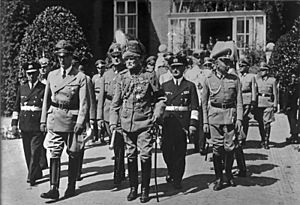
After Germany invaded Poland in September 1939, Canaris visited the front lines. He saw the terrible destruction caused by the German military. Seeing Warsaw burning made him very sad. He reportedly said, "Our children's children will have to bear the blame for this." He also saw war crimes committed by the SS, like the burning of a synagogue with 200 Polish Jews inside.
Canaris went to Hitler's headquarters on September 12, 1939. He protested the terrible acts. He told Wilhelm Keitel, the chief of the German armed forces, about the "extensive shootings." Keitel told him that Hitler had already decided these actions. Keitel warned Canaris not to protest further, as the plans came directly from Hitler.
Canaris then started working more actively to overthrow Hitler. He was promoted to full admiral in January 1940. When he learned about orders for brutal treatment of Soviet prisoners of war in September 1941, he complained again. Keitel reminded Canaris that this was not a "chivalrous war."
Heydrich noticed Canaris's complaints. He added them to a file about the Abwehr's "political unreliability." Canaris also worked to stop Operation Felix, Germany's plan to take Gibraltar.
At a meeting in Berlin in December 1941, Canaris said that the Abwehr had nothing to do with the persecution of Jews. He claimed they stayed out of it.
Canaris had a connection with a Polish spy in Switzerland, Halina Szymanska. She passed information from Canaris to the Polish government-in-exile in London. She also shared it with the British and Americans. A key piece of information from Canaris was an early warning about Operation Barbarossa, the German invasion of the Soviet Union.
In December 1940, Hitler sent Canaris to Spain. He was to convince Franco to support Germany in the war. But Canaris reported that Franco would not join until Britain was defeated. The Spanish government later paid a pension to Canaris's widow. Franco remained "forever grateful" to Canaris for his advice to keep Spain out of the war.
In June 1942, Canaris sent eight Abwehr agents to the East Coast of the United States. This was part of Operation Pastorius. Their mission was to damage American targets and lower morale. However, two weeks later, the FBI arrested all of them. Two Abwehr agents betrayed the mission. The arrested agents were tried by a military court. All were found guilty and sentenced to death. Two who cooperated with the FBI received life sentences. The others were executed. After this failure, there were no more sabotage attempts in the United States.
After 1942, Canaris often visited Spain. He likely met with British agents from Gibraltar. In 1943, in occupied France, Canaris met with the head of British Intelligence Services. Canaris wanted to know the terms for peace if Germany got rid of Hitler. British Prime Minister Winston Churchill's reply was simple: "Unconditional surrender."
Canaris also helped many victims of Nazi persecution, including Jews. He helped them escape danger. For example, he helped 500 Dutch Jews get to safety in May 1941. Many people were given fake training as Abwehr "agents." This allowed them to get papers and leave Germany. He is also said to have helped Rabbi Yosef Yitzchok Schneersohn. Because of this, some groups want him recognized as a Righteous Among the Nations.
Canaris's Downfall and Execution
Evidence grew that Canaris was working against the Nazis. In February 1944, Heinrich Himmler insisted that Hitler fire Canaris. The Abwehr was then shut down. Its duties were taken over by other SS intelligence groups. Canaris was put under house arrest for a time.
Canaris was arrested on July 23, 1944. This happened after his successor, Georg Hansen, was questioned. Hansen admitted his role in the 20 July plot to kill Hitler. He accused Canaris of being the "spiritual instigator." No direct proof of Canaris's involvement was found. But his close ties to many plotters and some of his writings made him seem guilty.
Investigations continued until April 1945. Then, orders came to execute the remaining prisoners from the plot. Canaris's personal diary was found and given to Hitler. This diary showed his involvement in the conspiracy. Canaris was tried by an SS court. He was charged with treason, found guilty, and sentenced to death.
Canaris was executed on April 9, 1945, at the Flossenbürg concentration camp. This was just weeks before the end of the war in Europe. A prisoner claimed to have heard Canaris tap a coded message on his cell wall. In it, Canaris said he was not a traitor. He said he acted out of duty to his country.
Two of Canaris's main assistants, Erwin von Lahousen and Hans Bernd Gisevius, survived the war. They testified at the Nuremberg trials. They spoke about Canaris's bravery in opposing Hitler. Lahousen remembered Canaris warning General Wilhelm Keitel that the German military would be blamed for the terrible acts in Poland. Keitel replied that Hitler had ordered them. Keitel was found guilty of war crimes at Nuremberg and executed.
Film Portrayals
- The 1954 film Canaris, starring O. E. Hasse, is based on his life.
- Anthony Quayle plays Wilhelm Canaris in the 1976 film The Eagle Has Landed.
- Wilhelm Canaris is also in the 1964 Czechoslovakian film The Assassination.
See also
 In Spanish: Wilhelm Canaris para niños
In Spanish: Wilhelm Canaris para niños


